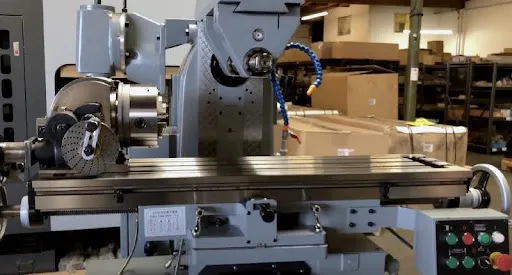09 July 2018
In the realm of machining, milling machines stand as essential tools, transforming raw materials into precision-engineered components. At their core, these mechanical devices are designed to shape and refine materials, operating on the principle of removing material from a workpiece using rotating cutting tools. This carefully controlled process plays a pivotal role in the production of intricate parts and components for various industries, making milling machines indispensable allies in the world of precision engineering and manufacturing.
Genesis of Universal Milling Machines:
In the relentless pursuit of machining perfection during the 19th century, the Universal Milling Machine emerged as a revolutionary response to the evolving needs of diverse milling tasks. As industries sought a more adaptable and efficient solution, engineers conceptualized a machine capable of both horizontal and vertical milling. Tracing its roots to 1861, the Universal Milling Machine was designed with a swiveling table and a rotating spindle to accommodate a wide range of cutting operations. This vision materialized into a versatile tool that would redefine the boundaries of milling operations, addressing the dynamic requirements of the ever-evolving manufacturing landscape.
Exploration of Versatility:
Central to the Universal Milling Machine’s prowess is its swiveling table, enabling horizontal and vertical movements. This unique design facilitates diverse milling tasks by adjusting the workpiece from various angles. The rotating spindle further elevates capabilities, ensuring precise angular milling and drilling operations. Crafted from heavy-duty cast iron, the machine’s durable construction ensures longevity and stability. What sets the Universal Milling Machine apart is its compatibility with an array of attachments, transforming it into a powerhouse capable of executing complex tasks with unparalleled precision. From indexing heads for angular positioning to rotary tables for circular milling, these attachments expand the machine’s capabilities.
Versatility in Action:
Universal milling machines find applications across industries, essential for producing components with intricate shapes and varying dimensions. Tool and die-making benefits from the machine’s adaptability, enabling the creation of molds and prototypes with unmatched precision. Its capability to handle both small-scale and large-scale production speaks to the machine’s versatility in meeting the diverse needs of modern industries.
Applications in Various Industries:
- Automotive Industry: Universal milling machines play a crucial role in producing complex components like transmission parts, engine blocks, and suspension system elements.
- Aerospace Industry: These machines are employed to fabricate critical components for aircraft engines and structural elements, ensuring precision in aerospace applications.
- Medical Equipment Manufacturing: Used in crafting precision parts for medical imaging devices, orthopedic implants, and other medical instruments.
- Tool and Die-Making: Essential for creating molds and prototypes, such as injection molds for plastic components, with unmatched precision.
- General Manufacturing: Employed for creating precision gears, components for consumer electronics, and various manufacturing tasks.
- Energy Sector: Contributes to the production of components, such as turbine parts, with diverse attachments ensuring precision.
The Dance of Cutting Tools: Universal Milling Machines surpass typical milling machines with a more comprehensive range of motion, featuring automatic feed and rapid traverse on the X-axis (left to right), Y-axis (in and out), and Z-axis (up and down). Operating both vertically and horizontally, they are compatible with an extensive array of cutting tools. The machine’s spindle accommodates various tools, empowering it to handle materials across a wide spectrum and meet diverse machining requirements. The worktable’s ability to swivel 45º on either side enhances its flexibility, facilitating precise helical milling work.
Differences Between a Plain and Universal Milling Machine:
While sharing fundamental characteristics, Plain and Universal Milling Machines have distinct features setting them apart:
Versatility: Universal mills function both vertically and horizontally, widening their machining capabilities. Plain mills primarily operate in a vertical mode, limiting their versatility.
Swiveling Ability: Universal milling machines can swivel, allowing angular adjustments for diverse machining possibilities. Plain milling machines lack this swiveling flexibility, limiting angular adjustments.
Applications: Universal Mills excel in creating gears, drills, reamers, and various milling and cutting operations. Plain mills are particularly suited for manufacturing operations, offering stability and precision.
Rigidity: Plain milling machines tend to exhibit greater rigidity, making them suitable for applications where stability is paramount. Universal milling machines might have less rigidity, focusing on versatility rather than sheer stability.
Manufacturing Operations: Plain mills are preferred for manufacturing operations, emphasizing robust construction. Universal mills are designed as tool room machines, prioritizing accuracy in producing precise work.
Disadvantages of Universal Milling Machines:
Despite their versatility and precision, Universal Milling Machines come with challenges. Their complexity makes them more challenging to maintain and operate, with additional components increasing the likelihood of breakdowns. The higher initial cost and ongoing maintenance expenses pose financial considerations, while safety concerns arise due to the machine’s numerous components. Adherence to stringent safety protocols is crucial to mitigate risks and ensure a secure working environment.
Conclusion: The Universal Milling Machine stands as a revolutionary force in the manufacturing industry, introducing an unparalleled level of precision and versatility. From its humble beginnings in the 19th century to its current status as a versatile powerhouse, this machine continues to adapt alongside evolving industries. As manufacturing complexities increase, the Universal Milling Machine remains ready to confront and surpass the challenges presented by the ever-evolving machining landscape.

